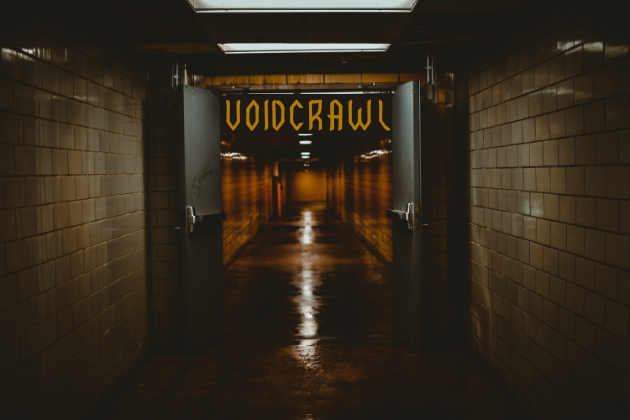Voidcrawl procedure for Liminal Horror

Adapted from mv’s blog derelictcrawl procedure for Mothership - hypertext corner
Appendix V: A turn based system for your Liminal Horror sessions that creates a procedure for exploring the dark and neglected spaces where those touched by the abyss reside. It uses an overloaded encounter 1 2
die to inform what happens next and bring the focus on the narrative.
the exploration turn
Time is divided into turns when exploring abandoned spaces (Liminal Spaces, catacombes, abyss warped environments, tunnels, ruins, empty towns, warehouses, non-euclidean megastructures, backrooms, etc) containing rooms/sections.
During a turn the party can perform one significant action:
- move between rooms
- searching/exploring a space
- forcing a door open
- Attempting to catch their break to regain HP (CTRL save to succeed)
- etc
Each exploration turn (after the crew declares their action) the Facilitator rolls the Voidcrawl die (d20)
Risk vs Reward: Pushing forward means losing the opportunities to rest/catch one’s breath (making regaining HP risky) - this means the party needs to choose whether to regain HP or move forward in a timely manner (each rest would necessitate a Voidcrawl roll afterward).
Voidcrawl Die (d20) table:
| Effect | Roll | Description |
|---|---|---|
| 1 | Dire Omen | Roll to determine a random player. Roll on a fallout table. Present an omen or portent relating to that fallout and is fated to be the next fallout they get. |
| 2-4 | Encounter | Facilitator rolls on an encounter table. If only one monster is in the location, they encounter it instead. |
| 5-7 | Horror | The crew discovers something frightening/horrific. each character gains 1-4 Stress. |
| 8-10 | Setback | The party encounters a setback (a hazard impeeds the party - either physical, enviromental, or magical). One option is to have scarcity set in (equipment breaks, depleting supplies). Focus on what is most relevant at that moment. |
| 11-13 | Locality | The environment changes around the party (alarm, pathway closes off, physical material of a space shifts, etc) |
| 14-16 | Clue | Present a hint, warning, or clue. {Shadows wreathed in blue flame, bullet holes, sizzling bloodstains}. Abilities and drives of the monsters can inform choice. |
| 17-19 | Free | No additional effect on this turn. Negative temporary effects end. |
| 20 | Regroup | The party is currently safe and can take a breather (regain HP without taking up their turn) |
The Facilitator can adjust the result to what would narratively make sense. One can adjacent entries to determine a new result. Going down the table (↓) results in a more positive event, while going up (↑) results in a negative one.
notes on doors and scale
As the party continues forth, there will be different setbacks and barriers.
- Locked doors: Locked doors are aplenty, and there is no single solution. A non-extensive list of adjudications might be
- Using force: uses an exploration turn and a STR check to force open. Failure may require additional turns, loss of items, damage, or alert others to your presence.
- Lock Picking: the lock pick is a trusty tool that only requires a successful DEX check (and does not take abn exploration turn, unless you fail of course).
- Magic Barriers: When the veil is thin between worlds, the risks of chaotic magics being encountered increase. From illusions, to reality warping spaces the dangers are real. CTRL saves, foolhardy endurance (STR), speed (DEX), or clever ideas can be used to navigate these barriers.
- Some actions are quick and success means not needing to use an Exploration Turn to resolve.
- Some actions, regardless of success or failure, take time.
- Bodily harm risks STR damage, esoteric harm risks Stress damage.
Most rooms only take one Exploration turn to explore. Some spaces are larger in size/scale.
| Scale | Description | Exploration |
|---|---|---|
| Human | Offices, hallways, living spaces | 1 turn |
| Industrial | factory floors, warehouse rooms, cargo loading, sewers. | 2-3 turns |
| The Vast | Caverns, warrens, non-euclidean spaces, areas not designed for human movement. | 3-4 turns |
The party can increase the pace of their exploration, but this may increase unwanted attention. They may explore at a faster rate (+1 human scale room/-1 turn to explore larger spaces) at the cost of having the Voidcrawl die be rolled at disadvantage3.
time
Turns are an abstract measure of the time required to take significant actions. If it becomes necessary to track times, a Exploration Turn would average around 10 minutes of in game time.
Text licensed under CC BY-SA-4.0
Overloading the encounter die was originally introduced in Overloading the encounter die by Necropraxis↩︎
Prismatic Wasteland gives a great summary of what an overloaded die is in their article on Exploding the Encounter Die: “the overloaded encounter die checks for random encounters, the expiration of light sources and other effects of traversing a dungeon with a single d6 roll. This method uses randomness to simulate a timer.”↩︎
disadvantage is when someone rolls two dice and takes the worst/more dangerous result.↩︎